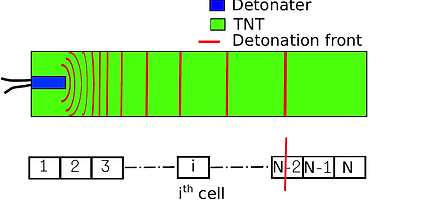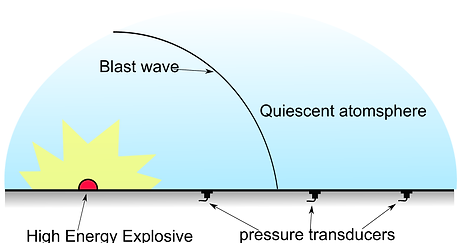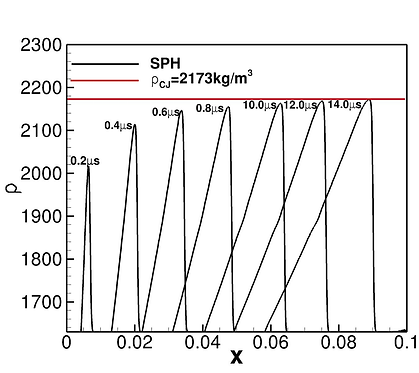To study blast loading of structures, it is essential to simulate detonation of the high energy explosive (HE). To achieve this, a simplistic model called the ‘Programmed burn model’ can be used. Based on the initial configuration of the explosive, the position of the detonation front can be calculated using the experimental value of detonation wave front speed (V_d). The position of the detonation wave (V_d * time after detonation) separates the reacted or detonated region from the un-reacted region of the explosive. The pressure in the reacted zone is then calculated using the Jones-Wilkins-Lee Equation of state (JWL-EOS).
JWL-EOS:
Here, A, B, r 1 , r 2 , ω are constants, depending on the type of explosive employed. For Pentolite, the following table gives the suitable values. The value of density and energy of un-reacted Pentolite are taken as ρ_e = 1650 kg/m^3 and E_0 = 4.85 × 10^6 J respectively.
Validation of the HE detonation Model:
For validation purpose, the detonation of one deimensional TNT slab of 0.1m length. The results of 1D TNT slab compare well with the available experimental solution and that of the Chapman-Jouguet (CJ) theory as shown below.
An axisymmetric SPH scheme proposed by Brookshaw (2003) along with the improvements suggested by
Garcia-Senz et al. (2009) is implemented in the in-house solver to simulate explosion in air.
For validation of the solver, the standard hemispherical surface free-field air blast problem is simulated, for which empirical relations are available. For this test, explosion of a Pentolite charge of mass 0.1kg in standard sea level ambient condition is considered. The variation of peak overpressure with the corrected scaled distance (Z) is plotted and compared against the empirical relation proposed by Kingery and Bulmash (2006) in the following figure.








Comparison of spatial distribution of a) pressure, b) density and c) velocity of the explosive at different time instants for 1D TNT slab detonation.
2D axisymmetric code for simulating air blast:
